How to plan a small garden – expert advice for petite patios and tiny lawns
Expert tips on how to design a small garden layout to benefit more from a tiny space

Designing a small garden might be a challenge, but with smart planning and savvy design thinking, there's no reason you can't make the most of your small garden ideas and enjoy endless happy moments in it. The key is to learn how to plan a small garden before you jump in and start decking out your space with plants and furniture.
Even tiny lawns and mini patios can be turned into garden spaces that are relaxing, practical, and aesthetic all at the same time. It's all about planning ahead and establishing your garden's priorities, which is where advice from garden design experts comes in really handy.
So if you've got a good idea of the garden ideas you'd like to incorporate into your outdoor space, but you're not really sure how to bring them to fruition, you've come to the right place. We've asked the experts to share all their advice on how to plan a small garden, and we've also selected our favourite small garden layouts to give you even more inspo.

How to plan a small garden
Our guide will take you through the necessary steps of how to plan a small garden, so that you don't have to compromise with your outdoor space. Obviously, how much you can include will depend on exactly what size of space you're working with. If it's a really small area, you may have to sacrifice certain elements, so choose wisely which aspects from our guide you want to include.
1. Establish your priorities
'When it comes to planning your small garden, it's important to decide what you want to get from the space available to you and who will be using it,' says Nathan Stevens, Director, Vivid Pods.
'Perhaps you want a space for lounging in the sunshine or cosying up with throws in the cooler evenings, or maybe you need a setup to support a BBQ,' says Jonny Brierly from Moda Furnishings. 'Ensure you know exactly what you want to use your garden for, exactly the same as you would design rooms in your house for specific uses.'
So before you even start learning how to plan a small garden, establish your priorities so that you can dedicate what space you have to them. Ask yourself questions such as:
Get the Ideal Home Newsletter
Sign up to our newsletter for style and decor inspiration, house makeovers, project advice and more.
Do I need additional living space?
Do I need a safe area for children to play?
Do I have time for gardening or do I need a low-maintenance garden?
'Answering these questions will help you to plan a garden that provides exactly what you need,' says Nathan.
2. Dedicate 'zones'

Once you've decided what you want your small garden to include, visualise what will go where and create 'zones' for the various garden activities. Having separate zones will help your small garden feel bigger, and you won't feel restricted in what you can use it for.
There could be a dining zone, a relaxing zone, and a play zone for the children, and you don't need loads of space to have all of these. You can separate them with something as simple as a row of potted plants, or any furniture you're including.
Think strategically about what should go where too. 'It’s important to consider where the sun rises and sets within your garden space, and which areas are shaded in your garden when you will likely to be enjoying it,' says Alysha Alli, Head of Interior Design, Redrow. 'This will help locate where to specifically plant but also where to locate your seating/relaxing/dining space within your garden.'
3. Place your furniture
As the aspect of the garden that takes up the most space, decide what garden furniture you will have and where this will go. This is why it's important to establish your priorities; if you want ample seating space and an area to relax, you need to account for this when planning. Or you may want to keep most of the floor space free for the kids to run around, and be happy with simple garden table ideas.
Smaller gardens will benefit from furniture grouped together. 'Sofa sets are a fantastic way to create an area for relaxing but that can be used as a dining area too if paired with a small table,' says Andy Baxter, Managing Director, Maze.
4. Pick your plants
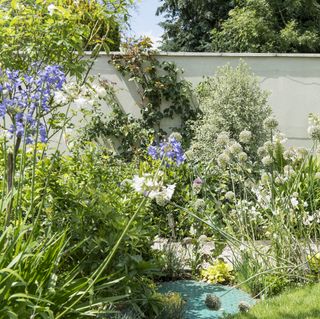
Now you've decided on your furniture and the layout of your small garden, it's time to fill out the remaining space with plants, glorious plants. Small gardens don't have to compromise on the variety and volume of plants they display either; utilise space that would otherwise go to waste with window boxes and climbing plants, or learn how to make a garden wall to create an eye-catching display of flowers.
Raised beds are another popular easy garden idea for small gardens, as they require little maintenance once planted.
5. Add the finishing touches
Complement any rattan garden furniture with throw rugs and cushions to make the seating area ultra relaxing. Then finish off your small garden with garden lighting ideas to make the most of the cosy, comforting space. Any accessories you add should make the garden feel homely, but not cluttered.
'Placing oversized lanterns, woven style candle holders and collections of clay and ceramic pots can look great grouped together around seating areas to further build on the ‘inside out’ look', says Alysha.
A top tip is to choose light-reflecting colours and add details you’d find indoors, such as mirrors, which will make a small garden look and feel bigger.
Small garden layouts
If you need some more inspo around the finer details of how to plan a small garden, here are our favourite small garden layouts that will help you make the most of your space.
1. Calming garden layout with containers and circular paving
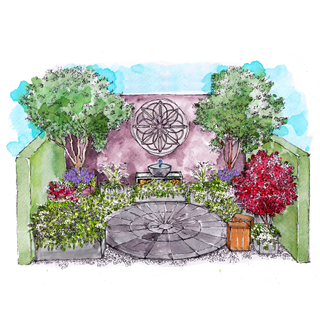
Nikki Hollier is no stranger to small gardens and will be exhibiting her small space container garden that's ideal for renters at RHS Chelsea 2022. The garden designer and Border in a Box founder's illustration above shows a calming space with a circular paved area and raised borders and containers. The relaxed feel is elevated with a water feature, casual seating and plants at a variety of heights that give the garden a more casual feel.
Will it take much looking after?
Containers will need regular watering in the warmer months, but with no lawn area to mow, this space is pretty low-maintenance.
Are there any space-stretching tricks I can use?
Lay an outdoor rug with a zig zag pattern to make the central area look bigger and paint walls or fences white or green.
How can I cut costs?
Work with existing plants you already have in your garden and be patient. Buy smaller pots of lavender and other border plants and in time they'll fill up the space without the need for spending lots of money.
2. Low maintenance layout for a small garden
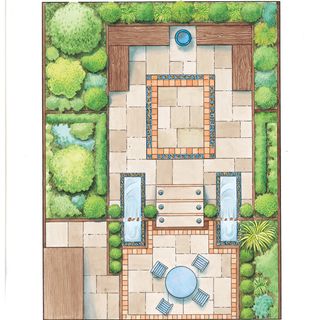
This two-level garden design by Katrina Wells of Earth Designs is linked by steps and flanked by split-level pools fed with waterfalls would give your space lots of interest. The design is bordered by raised flowerbeds with built-in bench seating, which can seat more guests than garden chairs.
A colourful buddleia is an ideal plant for this kind of garden; easy to care for, it will attract lots of bees and butterflies when it flowers.
Will it take much looking after?
'Raised garden beds are perfect for small gardens, as using them reduces maintenance', says Harry Paulin, Designer, WoodBlocX. 'Tending and watering is much easier thanks to the extra height and also because everything is neatly contained.'
Raised beds can be much easier to look after than borders and you won't need to get on all fours to tend them. The rest of this garden is given over to paving, which will only need an occasional sweep.
Are there any space-stretching tricks I can use?
An attractive standard plant, urn, or statuette at the end of the garden will provide a focal point. It will draw the eye to the garden's furthest part, tricking you into seeing it as larger than it is.
Benches with lift-up lids will provide more storage. If you need a play area for children, swap tiles for decking in the lower part of the garden and sink a hidden sandpit beneath a section of it.
'Corner and L-shaped raised beds with added tiers will provide extra planting space in small areas', Harry suggests.
How can I cut costs?
Raised beds look great, but will cost money to install, so you could opt for ground-level planting. Small gardens are more interesting if you add extras, like water features, but you could replace these with more borders. Another way to cut the cost of a garden makeover is to swap decorative paving for gravel or decking.
3. Small garden design for families
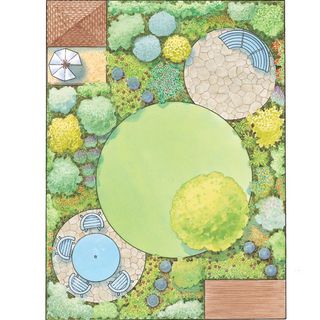
Strong shapes such as circles (arranged diagonally) will make a small garden appear wider and longer. At the heart of this garden is an open grassy circle (to give kids room to run about), while the smaller paved circles are used as seating/dining areas.
Stepping stones lead to a tucked-away play area. Children will also love the shape of the allium plant or ornamental onion. It flowers in early summer, likes most soils, and is easy to care for.
Will it take much looking after?
The lawn will need cutting once a week in the summer, and if you go for low-maintenance plants, such as hebes, you'll only need to give it a quick tidy.
Are there any space-stretching tricks I can use?
Paint walls and fences white to make space appear bigger, keep planting in borders low to make the garden seem wider, and go for a low-level chest storage unit instead of a tall shed.
How can I cut costs?
This is not an expensive garden to create, but if you're looking for budget small garden ideas, you could cut down on planting by making the central grassed area larger. Alternatively, you can stretch it into an oval to fill more of the borders.
4. Small secluded garden design
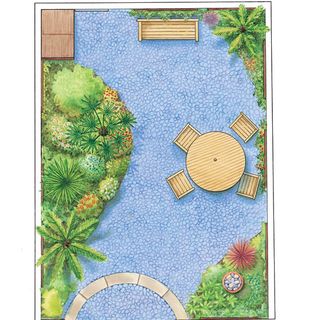
Want seclusion? Then this is the garden for you. All walls and fences have trellis panels fixed to their fronts and tops so that climbers can be trained up to hide the space from onlookers. The wide S-shaped path is cobbled for a relaxed feel, so make sure you choose a table and chairs with chunky legs to avoid wobble.
Go for low-maintenance exotics, which provide year-round interest, and place large plants, such as tree ferns and a windmill palm, in the borders. This will mean that the shed can't be seen from indoors and the bench is hidden from neighbouring houses. Passionflowers grow quickly but won't damage fences or brickwork if given supports, such as a trellis, to cling to.
Will it take much looking after?
Once planted, this garden will look after itself -- aside from the odd pruning of climbers, such as clematis, and the addition of some bright summer blooms, like lilies or poppies.
How can I cut costs?
There's an urn water feature here, but you could replace this with an eye-catching plant, such as zebra grass. Swap the patio cobbles for gravel, which is cheaper to buy and easier to lay. If you know you want a patio area, our small patio ideas and ways to make the most of a small paved area are sure to inspire.
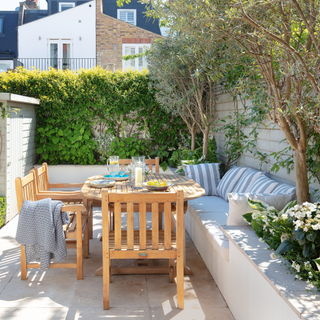
How do you arrange plants in a small garden?
'When planting a small garden, the focus should always be on maximising space', says Josh Novell, Plant Expert and Director of Polhill Garden Centre. 'External walls and windows are often forgotten about when it comes to gardens, but including a combination of trellis plants, climbing plants and window boxes can be a great way to add a variety of plants, colours and levels to a small garden, patio or balcony.'
Window boxes are ideal for small gardens because they utilise an area that would otherwise go to waste. They're an easy way to add colour, texture, and interest to your outdoor space. Climbing plants are another great option, because they can have a lot of impact, but only take up vertical space.
'There are a number of climbing plants which will thrive on a trellis, but it is important to ensure that the trellis is placed in an area with sufficient light,' says Josh. 'On a wall or fence with enough light and soil base will ensure that the climbing plants will thrive.'
How do you make a small garden look nice?
To make a small garden look nice, think about incorporating as much visual variety as possible into the space you have. An easy way to do this is via the plants, as they can take up as much or as little space as you'd like, and bring in plenty of different colours and variations. 'When choosing plants for your small garden, consider choosing plants with a lot of bold colours,' says Fiona Jenkins, Gardening Expert, MyJobQuote. 'This will allow you to create a garden space that really pops.'
Make the most of your outdoor eating space too. Add an interesting centrepiece to the garden table that complements the garden aesthetic, such as a ceramic pot or vase. 'Creating an outdoor eating space is a simple way to create extra space as well as encouraging you and your family to spend more time outdoors, helping you to relax after a long day at work without even leaving the house,' says designer Alysha.
Alysha recommends bringing interior elements outside to create a really homely space in the garden. Fairy lights, candles, and garden ornaments are a nice way to do this. 'The secret to a great design is blending the indoors with the outdoor space, so it provides another ‘room’ for you and your family to live, play, and eat in.'
How do you design a small garden?
Multifunctional items are your best friend. It's also well worth using your fencing and walls for planting, and choosing furniture that you can stow away. Mark Lane, gardening expert for stairlift and home lift company Stannah recommends maximising small outdoor spaces with mini-greenhouses, wall planters and fold-away tables and chairs.
Outdoor shelving, tiered planters, vertical gardens, self-contained water features, corner sheds and storage ladders are also great solutions. 'Seat storage solutions or a bike or bin store with a living roof can turn a minimal space into a multifunctional one,' Mark says.
Ash Read, interiors expert at Living Cozy says it's important to think about what you want from your garden and how it will fit in with your lifestyle. Then you can work out how to design it to meet these needs.
'Consider dividing your garden into different zones. A winding path through the plants can slow down the journey and trick any visitor into feeling like there is more space in your garden,' Ash reveals.
How do I make my garden beautiful in a small area?
'Do take into consideration the whole space, including anything overlooking it,' says Nikki Hollier. 'Can the surrounding views, for example, be incorporated into the garden to make it feel bigger? In Japanese, this concept is called Shakkei – a borrowed skyline.
'Keep colour simple and uncluttered – in my Chelsea garden, I am using white, soft pinks (for warmth) and shades of grey, all of which are restful and easy on the eye,' Nikki explains. The small garden expert goes on to say that it's a good idea to use a mixture of evergreens and perennials with different leaf shapes.
These will add texture and year-round colour and interest. 'And if you can, add a tree that is great for birds and bees. A crab apple is wonderful as it has blossom in the spring, fruits in late summer for the birds and amazing colour in the autumn,' she says.
She also suggests adding a comfortable and relaxing seating area so that you can relax with friends and chat over a cup of tea or a glass of wine.
Tamara was Ideal Home's Digital Editor before joining the Woman & Home team in 2022. She has spent the last 15 years working with the style teams at Country Homes & Interiors and Ideal Home, both now at Future PLC. It’s with these award wining interiors teams that she's honed her skills and passion for shopping, styling and writing. Tamara is always ahead of the curve when it comes to interiors trends – and is great at seeking out designer dupes on the high street.
- Millie HurstSenior Content Editor
- Katie SimsContributor
-
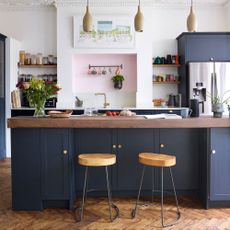 What colours work with navy kitchens? These are the go-to colour combos you need to know about
What colours work with navy kitchens? These are the go-to colour combos you need to know aboutTry these designer-approved colour combos to create a navy kitchen you’ll never want to leave
By Alisha Solanki
-
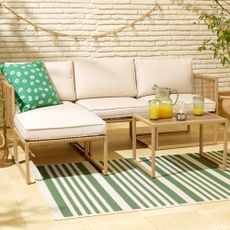 Tesco's designer-look modular sofa set is the star of its returning outdoor living range – and it's less than £300
Tesco's designer-look modular sofa set is the star of its returning outdoor living range – and it's less than £300It's a steal for small gardens
By Jullia Joson
-
 Is Habitat the new Zara Home? The affordable quiet luxury alternatives to snap up fast
Is Habitat the new Zara Home? The affordable quiet luxury alternatives to snap up fastHabitat is the new budget-friendly alternative for Zara Home – as lookalike quiet luxury homewares sell for less
By Sara Hesikova